Prime Minister of Croatia
The prime minister of Croatia (Croatian: Premijer / Premijerka Hrvatske), officially the president of the Government of the Republic of Croatia (Croatian: Predsjednik / Predsjednica Vlade Republike Hrvatske), is Croatia's head of government, and is de facto the most powerful and influential state officeholder in the Croatian system of government. Following the first-time establishment of the office in 1945, the 1990–2000 semi-presidential period is the only exception where the president of Croatia held de facto authority. In the formal Croatian order of precedence, however, the position of prime minister is the third highest state office, after the president of the Republic and the speaker of the Parliament.
| President of the Government of the Republic of Croatia
Predsjednik / Predsjednica Vlade Republike Hrvatske | |
|---|---|
 | |
| Government of Croatia Office of the Prime Minister | |
| Style |
|
| Type | Head of Government |
| Member of | Government of Croatia European Council (EU) Also: North Atlantic Council (NATO) |
| Reports to | Croatian Parliament |
| Seat | Trg sv. Marka 2, Zagreb, Croatia |
| Nominator | President of Croatia |
| Appointer | Croatian Parliament |
| Term length | At the pleasure of the parliamentary majority. Parliamentary elections must be held no later than 60 days after the expiration of a full parliamentary term of 4 years, but an incumbent Prime Minister shall remain in office in a caretaker capacity until a new government is confirmed in Parliament and sworn in by its Speaker. |
| Constituting instrument | Constitution of Croatia |
| Inaugural holder | Stjepan Mesić (de facto, after first multi-party election) Josip Manolić (de jure, under current Constitution) |
| Formation | 30 May 1990 (de facto, after first multi-party election) 22 December 1990 (de jure, under current Constitution) |
| Deputy | Deputy Prime Minister (position held by one or more members of the government) |
| Salary | HRK 21,655 monthly[2] |
| Website | www.vlada.gov.hr |
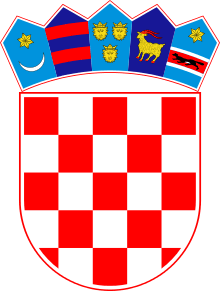 |
|---|
| This article is part of a series on the politics and government of Croatia |
|
Legislative
|
|
|
Recent elections
Recent referendums |
The Constitution of Croatia prescribes that "Parliament supervises the Government" (Article 81) and that "the President of the Republic ensures the regular and balanced functioning and stability of government" (as a whole; Article 94), while the Government is introduced in Article 108.[3] Since 2000, the prime minister has had various added constitutional powers and is mentioned before the Government itself in the text of the Constitution, in Articles 87, 97, 99, 100, 101, 103, 104.[3] The current prime minister of Croatia is Andrej Plenković. The Government of Croatia meets in Banski dvori, a historical building located on the west side of St. Mark's Square in Zagreb.
Name
The official name of the office, literally translated, is "President of the Government" (Predsjednik Vlade), rather than "Prime Minister" (Prvi Ministar). When the office was first established in 1945, the name "President of the Government" was introduced. The name of the office was changed 8 years later with the Yugoslav constitutional reforms of 1953, into "President of the Executive Council" (Predsjednik Izvršnog vijeća). After another round of constitutional reforms in 1990, the office was renamed back to its original 1945-1953 title of "President of the Government". For all periods, however, the term "Prime Minister" is colloquially used (especially in the media) in English-language usage.
History
The Royal Government of the Kingdom of Croatia-Slavonia (1868–1918) was headed by Ban (Viceroy), who represented the King. The first head of government of Croatia as a constituent republic of Federal People's Republic of Yugoslavia was Vladimir Bakarić, who assumed the position on 14 April 1945. The position was then, as it is today, the most powerful public office in the state (the only historical exception being the extremely powerful semi-presidential system used from 1990 until 2000, during which the president was by far the most significant figure in the government hierarchy). In post-World War II Socialist Republic of Croatia, a single-party system was in place. During this time there were twelve heads of government (using the title President of the Executive Council), all from the ranks of the Communist Party of Yugoslavia (KPJ), which was reformed and renamed into the League of Communists of Yugoslavia (SKJ) in 1952. The federal party was organized into six sub-organizations - the republic parties, one for each of the six federal republics. Croatian politicians and prime ministers of the period were members of the League of Communists of Yugoslavia through their membership in the League of Communists of Croatia (SKH), the Croatian part of the federal party (as was respectively the case with all Yugoslav politicians). The office remained the central post of Croatian politics in spite of the institution of a collective Presidency in 1974 (previously the mostly-nominal function of the head of state belonged to the Speaker of the Croatian Parliament, the Sabor).
After the constitutional amendments that allowed for multi-party elections in Croatia, the Parliament enacted amendments to the constitution (25 July) which eliminated socialist references and adopted new national symbols. The newly elected tricameral Parliament proceeded to change the Constitution of Croatia, and on 22 December 1990, this so-called "Christmas Constitution" fundamentally defined the Republic of Croatia and its governmental structure. From the 1990 constitutional reforms onward Croatia was a semi-presidential republic, which meant the president of Croatia had broad executive powers (further expanded with laws to a point of superpresidentialism), including the appointment and dismissal of the prime minister and other officials in the government. During this period, lasting until constitutional amendments in late 2000, Croatia had seven prime ministers. The first prime minister of Croatia since the 1990 constitutional reforms was Stjepan Mesić, assuming office on 30 May 1990.[4][5]
Following the May 1991 independence referendum in which 93% of voters approved secession, Croatia formally proclaimed independence from Yugoslavia on 25 June 1991, with Josip Manolić continuing in the role of prime minister as head of government of an independent Croatia. However, the country then signed the July 1991 Brijuni Agreement in which it agreed to postpone further activities towards severing ties with Yugoslavia. Meanwhile, the Croatian War of Independence ensued, and Franjo Gregurić was appointed to lead a Government of National Unity. In October the same year, Croatia formally severed all remaining legal ties with the Yugoslav Federation.
Following the January 2000 general election the winning centre-left coalition led by the Social Democratic Party amended the Constitution and effectively stripped the President of most of his executive powers, strengthening the role of the Parliament and the prime minister, turning Croatia into a parliamentary republic. The prime minister again (as before 1990) became the foremost post in Croatian politics.
To date there have been twelve Prime Ministers who have chaired 14 governments since the first multi-party elections. Nine prime ministers were members of the Croatian Democratic Union during their terms of office, two were members of the Social Democratic Party and one was not a member of any political party. Since independence there has been one female prime minister (Jadranka Kosor), while Savka Dabčević-Kučar was the first woman (not only in Croatia, but in Europe) to hold an office equivalent to a head of government as Chairman of the Executive Council of the Socialist Republic of Croatia (1967-1969).
Prime ministers of Croatia
Prime ministers of the Socialist Republic of Croatia within SFR Yugoslavia (1945–1990)
| No. | Portrait | Name (Birth–Death) |
Election | Term of office | Party | Cabinet | General Secretary (Term) | ||
|---|---|---|---|---|---|---|---|---|---|
| Term start | Term end | Duration | |||||||
| 1 | .jpg) |
Vladimir Bakarić (1912–1983) |
— | 14 April 1945 | 18 December 1953 | 8 years, 248 days | KPH Communist Party of Croatia (before 1952) |
Bakarić | Vladimir Bakarić 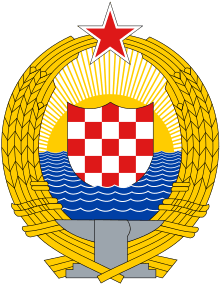 (1944–1969) |
| SKH League of Communists of Croatia (since 1952) |
1st Executive Council | ||||||||
| 2 | 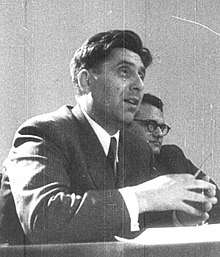 |
Jakov Blažević (1912–1996) |
— | 18 December 1953 | 10 July 1962 | 8 years, 204 days | SKH League of Communists of Croatia |
2nd Executive Council | |
| 3rd Executive Council | |||||||||
| 3 |  |
Zvonko Brkić (1912–1977) |
— | 10 July 1962 | 27 June 1963 | 352 days | SKH League of Communists of Croatia |
4th Executive Council | |
| 4 | 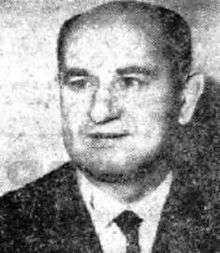 |
Mika Špiljak (1916–2007) |
— | 27 June 1963 | 11 May 1967 | 3 years, 318 days | SKH League of Communists of Croatia |
5th Executive Council | |
| 5 |  |
Savka Dabčević-Kučar (1923–2009) |
— | 11 May 1967 | 8 May 1969 | 1 year, 362 days | SKH League of Communists of Croatia |
6th Executive Council | |
| 6 |  |
Dragutin Haramija (1923–2012) |
— | 8 May 1969 | 28 December 1971 | 2 years, 234 days | SKH League of Communists of Croatia |
7th Executive Council |
Savka Dabčević Kučar  (1969–1971) |
| 7 |  |
Ivo Perišin (1925–2008) |
— | 28 December 1971 | 8 May 1974 | 2 years, 131 days | SKH League of Communists of Croatia |
8th Executive Council |
Milka Planinc  (1971–1982) |
| 8 |  |
Jakov Sirotković (1922–2002) |
— | 8 May 1974 | 9 May 1978 | 4 years, 1 day | SKH League of Communists of Croatia |
9th Executive Council | |
| 9 |  |
Petar Fleković (1932–) |
— | 9 May 1978 | 10 May 1982 | 4 years,
1 day |
SKH League of Communists of Croatia |
10th Executive Council | |
| 10 | 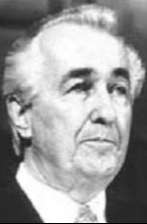 |
Ante Marković (1924–2011) |
— | 10 May 1982 | 10 May 1986 | 4 years | SKH League of Communists of Croatia |
11th Executive Council |
Jure Bilić (1982–1983) |
Josip Vrhovec (1983–1984) | |||||||||
Mika Špiljak (1984–1986) | |||||||||
| 12 |  |
Antun Milović (1934–2008) |
— | 10 May 1986 | 30 May 1990 | 4 years, 20 days | SKH League of Communists of Croatia (before January 1990) |
12th Executive Council |
Stanko Stojčević  (1986–1989) |
| SDP Social Democratic Party (since January 1990) |
Ivica Račan (1989–1990) | ||||||||
Prime ministers of the Republic of Croatia (1990–present)
Still a part of SFR Yugoslavia until 25 June 1991.
| No. | Portrait | Name (Birth–Death) |
Election | Term of office | Party | Cabinet | Composition | President (Term) | ||
|---|---|---|---|---|---|---|---|---|---|---|
| Term start | Term end | Duration | ||||||||
| 1 | _(cropped).jpg) |
Stjepan Mesić (1934–) |
1990 | 30 May 1990 | 24 August 1990 | 86 days | HDZ Croatian Democratic Union |
14th Executive Council (informally Mesić) |
HDZ | Franjo Tuđman 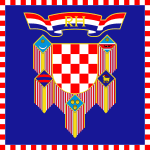 (1990–1999) |
| 2 | 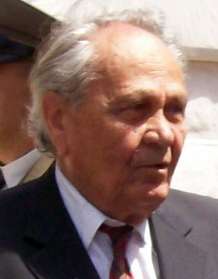 |
Josip Manolić (1920–) |
— | 24 August 1990 | 25 June 1991 | 327 days | HDZ Croatian Democratic Union |
Manolić | HDZ | |
| 25 June 1991 | 17 July 1991 | |||||||||
| 3 |  |
Franjo Gregurić (1939–) |
— | 17 July 1991 | 12 August 1992 | 1 year, 26 days | HDZ Croatian Democratic Union |
Gregurić | HDZ • SDP • HSLS • HNS • HKDS • HDS • SDSH • SSH | |
| 4 | 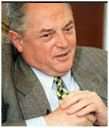 |
Hrvoje Šarinić (1935–2017) |
1992 | 12 August 1992 | 3 April 1993 | 234 days | HDZ Croatian Democratic Union |
Šarinić | HDZ | |
| 5 |  |
Nikica Valentić (1950–) |
— | 3 April 1993 | 7 November 1995 | 2 years, 218 days | HDZ Croatian Democratic Union |
Valentić | From 3 April 1993 to 31 December 1994: HDZ • HSS | |
| From 31 December 1994 to 7 November 1995: HDZ | ||||||||||
| 6 | 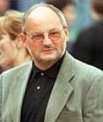 |
Zlatko Mateša (1949–) |
1995 | 7 November 1995 | 27 January 2000 | 4 years, 81 days | HDZ Croatian Democratic Union |
Mateša | HDZ | |
| Stjepan Mesić  (2000–2010) | ||||||||||
| 7 | 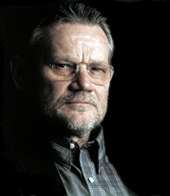 |
Ivica Račan (1944–2007) |
2000 | 27 January 2000 | 23 December 2003 | 3 years, 330 days | SDP Social Democratic Party |
Račan I | SDP • HSLS • HNS • HSS • IDS • LS | |
| Račan II | SDP • HSS • HNS • Libra • LS | |||||||||
| 8 | 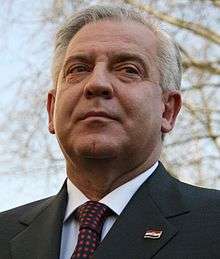 |
Ivo Sanader (1953–) |
2003 | 23 December 2003 | 6 July 2009 | 5 years, 195 days | HDZ Croatian Democratic Union |
Sanader I | HDZ • DC | |
| 2007 | Sanader II | HDZ • HSLS • HSS • SDSS | ||||||||
| 9 |  |
Jadranka Kosor (1953–) |
— | 6 July 2009 | 23 December 2011 | 2 years, 170 days | HDZ Croatian Democratic Union |
Kosor | HDZ • HSLS • HSS • SDSS | |
| Ivo Josipović  (2010–2015) | ||||||||||
| 10 | 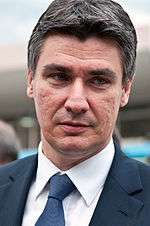 |
Zoran Milanović (1966–) |
2011 | 23 December 2011 | 22 January 2016 | 4 years, 30 days | SDP Social Democratic Party |
Milanović | SDP • HNS • IDS | |
| Kolinda Grabar Kitarović  (2015–2020) | ||||||||||
| 11 | 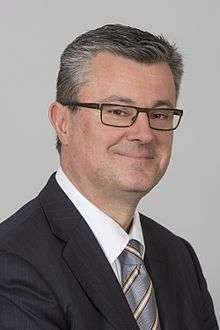 |
Tihomir Orešković (1966–) |
2015 | 22 January 2016 | 19 October 2016 | 271 days | Independent | Orešković | HDZ • MOST | |
| 12 | 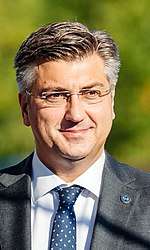 |
Andrej Plenković (1970–) |
2016 | 19 October 2016 | Incumbent | 3 years, 303 days | HDZ Croatian Democratic Union |
Plenković I | From 19 October 2016 to 28 April 2017: HDZ • MOST | |
| From 28 April to 9 June 2017: HDZ | ||||||||||
| From 9 June 2017 to 23 July 2020: HDZ • HNS |
Zoran Milanović  (2020–present) | |||||||||
| 2020 | Plenković II | HDZ • SDSS | ||||||||
See also
- List of Croatian Governments
- List of Croatian Prime Ministers by time in office
- President of Croatia
- List of Presidents of Croatia
- List of spouses of Croatian Presidents and Prime Ministers
- Speaker of the Croatian Parliament
- Secretary of the League of Communists of Croatia
- Politics of Croatia
- List of heads of state of Yugoslavia
- Prime Minister of Yugoslavia
- List of female county prefects in Croatia
Notes
- Denotes pre-independence Prime Ministers
- 1.^ From 1990 until the constitutional changes enacted in 2000, which replaced a powerful semi-presidential system (de facto a superpresidential system) with an incomplete parliamentary system, the term of the Prime Minister legally began on the date on which he was appointed by the President of the Republic and not on the date when he received a vote of confidence in Parliament, as is the case since 2000.
- 2.^ Until 12 October 2010.
Statistics
| # | Prime Minister | Age at ascension (first term) |
Time in office (total) |
Age at retirement (last term) |
Length of retirement | Lifespan |
|---|---|---|---|---|---|---|
| 1 | Stjepan Mesić | 55 years, 157 days | 86 days | 55 years, 243 days | 29 years, 359 days (Living) | 85 years, 237 days (Living) |
| 2 | Josip Manolić | 70 years, 155 days | 327 days | 71 years, 117 days | 29 years, 31 days (Living) | 100 years, 148 days (Living) |
| 3 | Franjo Gregurić | 51 years, 278 days | 1 year, 26 days | 52 years, 305 days | 28 years, 5 days (Living) | 80 years, 310 days (Living) |
| 4 | Hrvoje Šarinić | 57 years, 177 days | 234 days | 58 years, 45 days | 24 years, 109 days | 82 years, 154 days |
| 5 | Nikica Valentić | 42 years, 130 days | 2 years, 218 days | 44 years, 348 days | 24 years, 284 days (Living) | 69 years, 267 days (Living) |
| 6 | Zlatko Mateša | 46 years, 143 days | 4 years, 81 days | 50 years, 224 days | 20 years, 203 days (Living) | 71 years, 61 days (Living) |
| 7 | Ivica Račan | 55 years, 337 days | 3 years, 330 days | 59 years, 302 days | 3 years, 127 days | 63 years, 64 days |
| 8 | Ivo Sanader | 50 years, 198 days | 5 years, 195 days | 56 years, 28 days | 11 years, 42 days (Living) | 67 years, 70 days (Living) |
| 9 | Jadranka Kosor | 56 years, 5 days | 2 years, 170 days | 58 years, 175 days | 8 years, 238 days (Living) | 67 years, 47 days (Living) |
| 10 | Zoran Milanović | 45 years, 54 days | 4 years, 30 days | 49 years, 84 days | 4 years, 208 days (Living) | 53 years, 292 days (Living) |
| 11 | Tihomir Orešković | 50 years, 21 days | 271 days | 50 years, 292 days | 3 years, 303 days (Living) | 54 years, 229 days (Living) |
| 12 | Andrej Plenković | 46 years, 194 days | 3 years, 303 days (Ongoing) | Incumbent | Serving | 50 years, 131 days (Living) |
Spouses of prime ministers
| Name | Relation to Prime Minister |
|---|---|
| Milka Mesić (née Dudunić) | wife of Prime Minister Stjepan Mesić |
| Marija Eker Manolić | wife of Prime Minister Josip Manolić |
| Jozefina Gregurić (née Abramović) | wife of Prime Minister Franjo Gregurić |
| Erika Šarinić | wife of Prime Minister Hrvoje Šarinić |
| Antonela Valentić | wife of Prime Minister Nikica Valentić |
| Sanja Gregurić-Mateša | wife of Prime Minister Zlatko Mateša |
| Dijana Pleština | wife of Prime Minister Ivica Račan |
| Mirjana Sanader (née Šarić) | wife of Prime Minister Ivo Sanader |
| Jadranka Kosor divorced before becoming prime minister | |
| Sanja Musić Milanović | wife of Prime Minister Zoran Milanović |
| Sanja Dujmović Orešković | wife of Prime Minister Tihomir Orešković |
| Ana Maslać Plenković | wife of Prime Minister Andrej Plenković |
Living former heads of government of Croatia
There are eleven living former heads of government (2 former presidents of the Executive Council of SR Croatia and 8 former prime ministers of Croatia). The last former head of government to die was Hrvoje Šarinić (1992–1993) on 21 July 2017.
Presidents of the Executive Council of the Socialist Republic of Croatia (until 1990):
.jpg)
Petar Fleković
(1978–1982)
September 14, 1932_(cropped).jpg)
Stjepan Mesić
(1990)
December 24, 1934
Prime ministers of the Republic of Croatia (1990–present):

Josip Manolić
(1990–1991)
March 22, 1920
Franjo Gregurić
(1991–1992)
October 12, 1939
Nikica Valentić
(1993–1995)
November 24, 1950
Zlatko Mateša
(1995–2000)
June 17, 1949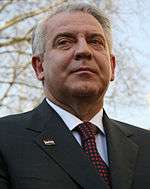
Ivo Sanader
(2003–2009)
June 8, 1953
Jadranka Kosor
(2009–2011)
July 1, 1953
Zoran Milanović
(2011–2016)
October 30, 1966
Tihomir Orešković
(2016)
January 1, 1966
Facts and records of Croatian prime ministers (since 30 May 1990)
Age at appointment
- Oldest person to assume office: Josip Manolić (70 years, 155 days)
- Youngest person to assume office: Nikica Valentić (42 years,130 days)
Age at retirement
- Oldest person to leave office: Josip Manolić (71 years, 117 days)
- Youngest person to leave office: Nikica Valentić (44 years, 348 days)
Oldest and youngest living prime ministers
- Oldest living prime minister: Josip Manolić (100 years, 148 days)
- Youngest living prime minister: Andrej Plenković (50 years, 131 days)
Longest and shortest lived prime ministers
- Longest-lived prime minister: Josip Manolić (100 years, 148 days)
- Shortest-lived prime minister: Andrej Plenković (50 years, 131 days)
Longest and shortest retirements
- Living prime minister with the longest period lived after leaving office: Stjepan Mesić (29 years, 359 days)
- Living prime minister with the shortest period lived after leaving office: Tihomir Orešković (3 years, 303 days)
- Deceased prime minister with the longest period lived after leaving office: Hrvoje Šarinić (24 years, 109 days)
- Deceased prime minister with the shortest period lived after leaving office: Ivica Račan (3 years, 127 days)
Age difference between incoming and outgoing officeholders
- Largest age difference between an incoming and outgoing prime minister: Franjo Gregurić (born 12 October 1939) was 19 years, 204 days younger than Josip Manolić (born 22 March 1920) whom he succeeded in 1991.
- Smallest age difference between an incoming and outgoing prime minister: Jadranka Kosor (born 1 July 1953) was 23 days younger than Ivo Sanader (born 8 June 1953) whom she succeeded in 2009.
Length of service
- Longest-serving prime minister: Ivo Sanader (5 years, 195 days)
- Shortest-serving prime minister: Stjepan Mesić (86 days)
Terms of office and number of cabinets
- Two terms in office: Ivo Sanader (2003–2008, 2008–2009), Ivica Račan (2000–2002, 2002–2003) and Andrej Plenković (2016-2020, 2020-)
- One term in office: Stjepan Mesić (1990), Josip Manolić (1990–1991), Franjo Gregurić (1991–1992), Hrvoje Šarinić (1992–1993), Nikica Valentić (1993–1995), Zlatko Mateša (1995–2000), Jadranka Kosor (2009–2011), Zoran Milanović (2011–2016) and Tihomir Orešković (2016)
- Prime Ministers who won the most parliamentary elections: Ivo Sanader (2003 and 2007) and Andrej Plenković (2016 and 2020)
- Prime Minister who headed the most cabinets while in office: Ivo Sanader, Ivica Račan and Andrej Plenković (each headed two cabinets)
- Cabinet with longest duration: Cabinet of Zlatko Mateša (4 years, 81 days)
- Cabinet with shortest duration: Cabinet of Stjepan Mesić (formally 14th Executive Council of the Parliament of SR Croatia) (86 days)
Size of cabinet
- Prime Minister of cabinet with largest number of members during its duration (including removed or deceased members): Franjo Gregurić (45 members including the Government secretary)
- Prime Minister of cabinet with smallest number of members during its duration (including removed or deceased members): Ivo Sanader (19 members in First Sanader cabinet)
- Prime Minister of cabinet with largest number of members on date of formation: Josip Manolić (27 members named on 17 July 1990)
- Prime Minister of cabinet with smallest number of members on date of formation: Stjepan Mesić (5 members named on 30 May 1990. Another 15 named on 31 May 1990)
- Prime Minister of cabinet with largest number of members on date of dissolution (excluding removed or deceased members): Franjo Gregurić (30 members on 12 August 1992)
- Prime Minister of cabinet with smallest number of members on date of dissolution (excluding removed or deceased members): Ivo Sanader (14 members on 12 January 2008 upon dissolution of First Sanader Cabinet)
Number of political parties in cabinet
- Prime ministers of cabinets with largest number of political parties represented in them during their total duration (including removed or deceased members on date of dissolution): Franjo Gregurić (8 parties had representation in his cabinet during some part of its time in office)
- Prime ministers of cabinets with the smallest number of political parties represented in them during their total duration (including removed or deceased members): Stjepan Mesić, Josip Manolić, Hrvoje Šarinić and Zlatko Mateša (each prime minister had only 1 party (the HDZ) represented in their cabinet)
- Prime minister of cabinet with the largest number of parties represented in it on the date of its formation: Ivica Račan (6 parties had representation in his First cabinet on 27 January 2000)
- Prime ministers of cabinets with the smallest number of parties represented in them on the date of their formation: Stjepan Mesić, Josip Manolić, Hrvoje Šarinić and Zlatko Mateša (each prime minister had only 1 party (the HDZ) represented in their cabinet on the date it was formed)
- Prime minister of the cabinet with the largest number of political parties represented in it on the date of its dissolution: Ivica Račan (5 parties were represented in his Second cabinet on 23 December 2003)
- Prime ministers of cabinets with the smallest number of political parties represented in them on the date of their dissolution: Stjepan Mesić, Josip Manolić, Franjo Gregurić, Hrvoje Šarinić, Nikica Valentić, Zlatko Mateša and Ivo Sanader (First cabinet) (each prime minister had only 1 party (the HDZ) represented in their cabinet on the date it was dissolved)
Female prime ministers
- First female prime minister: Jadranka Kosor
Other national and international offices held after retirement
- Only prime minister to have held the three highest offices of government: Stjepan Mesić — Prime Minister (1990), Speaker of Parliament (1992–1994) and President (2000–2010)
- Only prime minister to have served as head of state of another independent country: Stjepan Mesić (as President of the Presidency of Yugoslavia from 1990–1991)
- First prime minister elected president: Stjepan Mesić (in 2000)
- First prime minister elected Speaker of Parliament: Stjepan Mesić (in 1992)
- First prime minister elected Speaker of the Chamber of Counties (upper house of Croatian Parliament until 2001): Josip Manolić (in 1993)
- Only prime minister to become Secretary General of the Non-Aligned Movement: Stjepan Mesić (as President of the Presidency of Yugoslavia)
Foreign-born prime ministers
- Ivica Račan was born in Ebersbach (then-Nazi Germany), now Ebersbach-Neugersdorf, Germany
Prime ministers born in predecessor states of modern Croatia (before 1991)
- Prime ministers born in:
- Kingdom of Yugoslavia (1918–1945) (known as the Kingdom of Serbs, Croats and Slovenes until 1929) (4): Josip Manolić (1920), Stjepan Mesić (1934), Hrvoje Šarinić (1935) and Franjo Gregurić (1939)
- Socialist Federal Republic of Yugoslavia (1945–1991) (7): Zlatko Mateša (1949), Nikica Valentić (1950), Ivo Sanader (1953), Jadranka Kosor (1953), Zoran Milanović (1966), Tihomir Orešković (1966) and Andrej Plenković (1970)
Period lived before Croatian independence was declared (25 June 1991)
- Oldest (future or previous) prime minister on date of Croatia's declaration of independence: Josip Manolić (71 years, 95 days)
- Youngest (future or previous) prime minister on date of Croatia's declaration of independence: Andrej Plenković (21 years, 78 days)
Service under the most heads of state
- Prime ministers who served under the most Presidents (excluding Acting Presidents): Jadranka Kosor, Zoran Milanović and Andrej Plenković (all three served under two presidents — Stjepan Mesić and Ivo Josipović (Kosor), Ivo Josipović and Kolinda Grabar-Kitarović (Milanović), Kolinda Grabar-Kitarović and Zoran Milanović (Plenković))
- Prime ministers who served under the most heads of state (including Acting Presidents): Ivica Račan (served under three heads of state — Acting Presidents Vlatko Pavletić and Zlatko Tomčić and President Stjepan Mesić)
- "Archived copy" (PDF). Archived from the original (PDF) on 2012-11-16. Retrieved 2012-11-16.CS1 maint: archived copy as title (link), Protocol and Liaison Service, United Nations.
- Thomas, Mark. "Croatian political salaries - how much do Croatia's leading political figures earn - The Dubrovnik Times". www.thedubrovniktimes.com.
- "The Constitution of the Republic of Croatia (consolidated text)". Croatian Parliament. Archived from the original on 2012-03-14. Retrieved 2011-02-16.
- "Chronology of Croatian governments" (in Croatian). Croatian Information-Documentation Referral Agency. Archived from the original on 2012-02-22. Retrieved 2011-05-13.
- "Prethodne Vlade RH" [Former Governments of the Republic of Croatia] (in Croatian). Croatian Government. Archived from the original on 2011-11-23. Retrieved 2010-12-13.
.jpg)